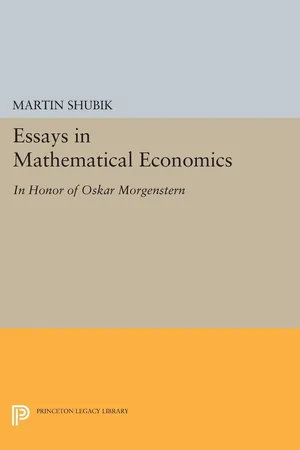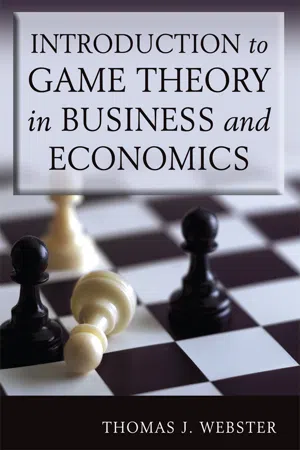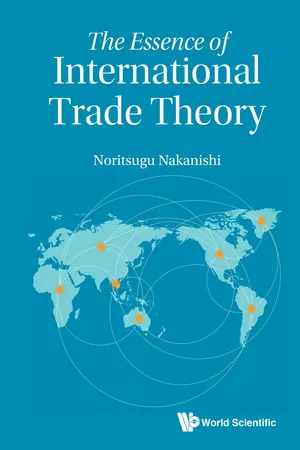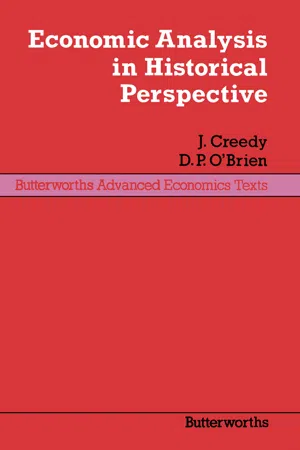Business
Cournot Oligopoly
Cournot oligopoly is a market structure in which a small number of firms compete by setting their quantities of output. Each firm assumes that its rivals' quantities will remain constant and makes production decisions based on this assumption. This model allows firms to strategically choose their output levels to maximize their profits, taking into account the reactions of their competitors.
Written by Perlego with AI-assistance
Related key terms
1 of 5
11 Key excerpts on "Cournot Oligopoly"
- Martin Shubik(Author)
- 2015(Publication Date)
- Princeton University Press(Publisher)
PART V Management Science CHAPTER 19 Some Notes on Oligopoly Theory and Experiments By DAVID H. STERN* The market situation in which a small number of sellers (two or more) are competing with each other in selling to a public consisting of many buyers is called oligopoly. In the three sections of this paper we analyze the structure of a certain class of oligopoly markets, catalog several of the hypotheses that have been suggested for the behavior of firms in such markets, and describe the procedure and results of several laboratory experiments aimed at providing evidence concerning the truth of these hypotheses. The first attempt to analyze oligopoly markets was made by Augustin Cournot in 1838; 1 in this paper we will be concerned with a market model only slightly more general than his. Our model involves five kinds of variables: number of business firms; market price; and, for each firm, quantities produced, unit cost of production, and profits. Other variables, such as advertising, investment in plant and equipment, market power, re- search and development, and personality differences between business- men, are covered by a general ceteris paribus assumption. Of the included variables, only the quantities produced by each firm are decision variables; hence we call our model the Cournot quantity oligopoly model. 2 The symbols we will need to specify this model are: η Number of sellers. qi (i = 1,. . ., n) Quantity of product produced and supplied to the market by „ seller /. Q = Σ ΐ i Total quantity of product pro- t=1 duced and supplied to the market by all sellers. * Unaffiliated, residing in San Diego, California. This work was supported partly by the Office of Naval Research under Task 047-003 (Management Sciences Research Project), and partly by the Western Management Science Institute under a grant from the Ford Foundation. Reproduction in whole or in part is permitted for any purpose of the United States Government.- eBook - PDF
Microeconomics
A Global Text
- Judy Whitehead(Author)
- 2020(Publication Date)
- Routledge(Publisher)
The game theory approach to modelling oligopoly in terms of competitors in a game with strategies and counter-strategies may be included among the traditional models. The models may be summarized as follows. Non-collusive models • The Cournot duopoly model • The Bertrand/Edgeworth duopoly model • The Chamberlin duopoly model. • The Sweezy Kinked Demand model. • The Stackleberg Solution model of ‘the sophisticated Duopolist’ 334 THE COURNOT MODEL 12.2 Collusive models • Cartels • Price leadership • The low cost price leader • The dominant firm price leader • The barometric price leader Game theory The two-person, zero-sum, strictly determined game. Game theory provides an alternative way to model oligopoly in terms of strategy and counter-strategy. The two-person, zero-sum, strictly determined game is one of the simplest forms of the game that allows a clear insight into how the model works. These models are dealt with seriatim. 12.2 THE COURNOT MODEL A study of the non-collusive models reveals that although the firms in the industry recognize their interdependence and this affects their behaviour, they do not resort to collusion. This, of course, tends to reduce firm and industry profits, reduce price and increase output. The Cournot model is one of the earliest oligopoly models and, in its original form, is a duopoly model (two sellers). It is associated with the economist A. Cournot (1801–1877), who first presented the model in 1838, writing later in 1897. It is a costless production model related to sale of water from mineral springs. 12.2.1 Assumptions of the Cournot model 1 The model is closed. There are two sellers of mineral water – each owns a mineral spring and no further entry takes place. 2 Both firms aim to maximize profit. 3 The firms have zero operating costs (hence TC = AC = MC = 0). Thus production is costless. 4 Firms sell in a market with a straight-line, negatively sloped demand curve. - eBook - PDF
Industrial Organization
Contemporary Theory and Empirical Applications
- Lynne Pepall, Dan Richards, George Norman(Authors)
- 2013(Publication Date)
- Wiley(Publisher)
Augustin Cournot, a French mathematician, published his model in 1836. Although its insights remained largely unrecognized for the next 100 years, it is now at the foundation of models of oligopolistic markets. The story that Cournot told to motivate his analysis went as follows. Assume a single firm wishes to enter a market currently supplied by a monopoly. The entrant is able to offer a product that is identical in all respects to that of the incumbent monopolist and to produce it at the same unit cost. Entry is attractive because under the assumption of constant and identical costs, we know that the monopolist is producing where price is greater than marginal cost, which means that the price also exceeds the marginal cost of the would-be entrant. Hence, the entrant firm will see that it can profitably sell some amount in this market. However the new entrant will, Cournot reasoned, choose an output level that maximizes its profit, after taking account of the output being sold by the monopolist. Of course, if entry occurred and the new firm produced its chosen output, the monopolist would react. Before entry, the monopolist chose a profit-maximizing output assuming no other rivals. Now, the former monopolist will have to re-optimize and choose a new level. In so doing, the monopolist will (as did the new entrant previously) choose an output level that maximizes profits given the output sold by the new rival firm. This process of each firm choosing an output conditional on the other’s output choice is to be repeated—at least as a mental exercise. For every output choice by the incumbent, firm 1, the entrant, firm 2, is shown to have a unique, profit-maximizing response and vise-versa. Cournot called the graph representations of these responses Reaction Curves. Each firm has its own Reaction Curve that can be graphed in the q 1 q 2 quadrant. - eBook - PDF
Intermediate Microeconomics
A Tool-Building Approach
- Samiran Banerjee(Author)
- 2021(Publication Date)
- Routledge(Publisher)
Chapter 13 Oligopoly Just as economists make sense of what happens in competitive markets in terms of the market equilibrium that arises from the interaction of demand and supply, in an oligopolistic equilibrium, the behavior of firms corresponds to that of a Nash equilibrium (NE), i.e., each firm is maximizing its profit given the actions of the others. Oligopolies are usually modeled in one of two ways: firms either choose the quantities they wish to produce ( quantity competition ), or they choose the prices they wish to charge ( price competition ). While the game-theoretic ideas are exactly the ones introduced in Chapter 12, the only difference is that the firms typically choose their actions from a continuum rather than a finite set of discrete options. For instance, under quantity competition, a firm can choose any output ranging from zero to its capacity; under price competition, a firm can charge any price ranging from its marginal cost of production to the maximum price that buyers are willing to pay for it. 13.1 Static Quantity Competition We begin with an example of the classic duopoly model of Augustin Cournot that dates back to 1838 but is still one of the most important ways in which economists think about quantity competition. 13.1.1 Cournot duopoly Two firms produce a homogeneous good. Firm 1 produces quantity q 1 and 2 produces q 2 , so the total quantity produced is Q = q 1 + q 2 . The firms face 242 Oligopoly 243 an inverse market demand given by p = 200 − Q , or p = 200 − q 1 − q 2 . It costs each firm $20 to produce each unit of output. We assume that each firm chooses its own output taking as given the other firm’s production level. Graphical representation One way to find an NE for this problem graphically is to plot each firm’s best-response to the other firm’s output choice and find a point of mutual best-response. To do so, assume that firm 2 has chosen its output level arbitrarily at q 2 . - Thomas J. Webster(Author)
- 2018(Publication Date)
- Routledge(Publisher)
We will begin our discussion with a graphical description of the Cournot model . We will then reformulate the Cournot model as a static, output-setting game involving continuous strategies. The Cournot model is significant because it highlights the central role of strategic behavior in imperfectly competitive markets. F IGURE D8.1 Solution to Demonstration Problem 8.1 IMPERFECT COMPETITION 181 Cournot model A static output-setting game in which firms in the same industry cannot subsequently switch strategies without great cost. In the Cournot model, prices adjust to firms’ output decisions to clear the market. The Cournot model is an output-setting game in which rival firms simultaneously determine their optimal output. An important assumption is that once output is determined, it cannot be changed, or at least not without significant economic cost. In the Cournot model, output is the only decision variable. Once the firms’ output levels are determined, the market price adjusts to equate consumer demand with total industry supply. This functional relationship is summarized in Equation (8.1). P P Q dP Q dQ T T T = ( ) ( ) < ; 0 (8.1) where Q Q T i i n = = ∑ 1 (8.2) Our objective is to determine the Nash equilibrium output level for each firm in this one-time, static game in which player strategies are continuous. To simplify the analysis, we will assume that the industry comprises two profit-maximizing firms producing a homogeneous product. We will also assume linear market demand and constant marginal cost, which will be set equal to zero for diagrammatic convenience. These assumptions are depicted in Figure 8.3. We will analyze this static, output-setting game from firm A ’s perspective. To maximize profits, firm A will produce at an output level where MC = MR A . Since we have assumed that MC = 0, firm A will first consider producing at output level Q A at a price of P 1 . Since MC = 0, maximizing profits is equivalent to maximizing total revenue.- eBook - ePub
- Noritsugu Nakanishi(Author)
- 2018(Publication Date)
- WSPC(Publisher)
4Free entry and the number of firms: In order to make an appropriate decision in a strategic situation, each agent has to take full account of how the other agents behave. Therefore, it is important for each agent to know who are (potentially) involved or, at least, how many rival agents are involved in the situation. When the market for a good is dominated by a single supplier firm, the situation is called monopoly. The situation with plural (but finite) supplier firms is called oligopoly. In particular, the situation with two firms is called duopoly. The number of firms may not be fixed. We distinguish two cases: one where the number of firms is given and fixed at the outset and the other where the number of firms is determined endogenously in the model. When a firm can enter and exit the market without incurring any additional cost, we say that free entry–exit prevails. If a potential firm finds it profitable to enter the market, it will do so. In contrast, if an incumbent firm suffers from a negative profit, it will exit the market. In this way, the number of firms changes and the profits of firms will vanish in the long run. By the term “long run” here, we mean a situation where the entry–exit by firms ceases and the number of firms is determined.5.1.2The Base Model
Consider a world economy consisting of two symmetric countries A and B, each of which can produce both an oligopolistic good and a homogeneous good. The homogeneous good is taken as the numèraire. In country s (= A, B), there is a single firm that produces the oligopolistic good, which is called “firm s” for simplicity. Without international trade, firm s is a monopoly in country s - eBook - PDF
- Jianwei Huang, Lin Gao(Authors)
- 2022(Publication Date)
- Springer(Publisher)
• Firms compete by setting production quantities simultaneously. The total output quantity affects the market price; • The firms are economically rational and act strategically, seeking to maximize profits given their competitors’ decisions. For simplicity, we consider a Cournot model between two firms, I = {1, 2}. Each firm i decides his output quantity q i , under a fixed unit producing cost c i . The market-clearing price is a decreasing function of the total quantity Q = q 1 + q 2 , denoted by P (Q). In such a competition model, what is the best quantity choice of each firm? We first translate the problem into a strategic form game—Coutnot Game. Recall from Defi- nition 6.1, we have the following strategic form representation of this Cournot game: • The set of players is I = {1, 2}, • The strategy set available to each player i ∈ I is the set of all nonnegative real numbers, i.e., q i ∈ [0, ∞), • The payoff received by each player i is a function of both players’ strategies, defined by i (q i , q −i ) = q i · P (Q) − c i · q i . The first term denotes the player i ’s revenue from sell- ing q i units of products at a market-clearing price P (Q), and the second term denotes the player i ’s production cost. Next we identify the Nash equilibrium of this Cournot game. Given player 2’s strategy q 2 , player 1’s payoff (profit) is a function of his quantity q 1 , 1 (q 1 , q 2 ) = q 1 · P (q 1 + q 2 ) − c 1 · q 1 . 6.2. THEORY: OLIGOPOLY 99 0 q 1 q 2 a − c 1 1 2 (a − c 2 ) a − c 2 1 2 (a − c 1 ) B 1 (q 2 ) B 2 (q 1 ) Nash Equilibrium Figure 6.5: The Cournot Game. The best response of player 1 is the strategy q 1 which maximizes this function, given player 2’s strategy q 2 . The optimal strategy for player 1 needs to satisfy the following first-order condition (ignoring boundary conditions): q 1 · P (q 1 + q 2 ) + P (q 1 + q 2 ) − c 1 = 0. As an example, we assume that P (q 1 + q 2 ) = a − q 1 − q 2 . - eBook - PDF
Economic Analysis in Historical Perspective
Butterworths Advanced Economics Texts
- J. Creedy, D.P. O'Brien(Authors)
- 2014(Publication Date)
- Butterworth-Heinemann(Publisher)
This outcome may, of course, be impeded by factors other than collusion. Conditions of exit will be unpropitious if loss-making, inefficient firms can hang on with average variable costs less than the total costs of a potential entrant. Subsidies and protective labour market legislation may create further barriers to exit. Andrews and Brunner (1975) define the industry in terms of firms with similar production processes capable in any given time period of producing a range of products, rather than in terms of product markets and consumer preferences. Since oligopoly is concerned with producer competition this is distinctly helpful. Their analysis of the industry is also realistically dynamic. The boundaries of the industry will be constantly changing, as will its member-firms' positions in individual product markets, as potential competition exerts its pressure. Firms will both supply and compete with each other, and small firms will be potential competitors with units or divisions of large firms. There will not, however, be continual price changes. Competition will work through the fixing of entry-deterring, normal-cost pricing, embellished by a complex mixture of product competition and price adjustment. 5.5.3 OLIGOPOLY, MANAGERIAL THEORIES AND THE GROWTH OF THE FIRM Cross-entry competition implies a model of the firm much closer to the 'new' theories of the firm than the standard textbook exhibit. The 144 Oligopoly and the theory of the firm price-fixing process of an entry-deterring, normal cost oligopolist will surely bear a close resemblance to Baumol's profit-constrained sales revenue-maximizer, if the threat of potential competition, which a sales maximizer is bound to encounter, is built into the profit constraint. If entry-deterrence is taken into account the scope for discretionary expenditures by managers may be significantly reduced (Williamson, 1964). - eBook - PDF
Agents, Games, and Evolution
Strategies at Work and Play
- Steven Orla Kimbrough(Author)
- 2011(Publication Date)
- Chapman and Hall/CRC(Publisher)
Permission from Springer to republish this material is gratefully acknowledged. Chapter 11 Oligopoly: Bertrand Competition 11.1 Price Competition The Bertrand model models competition on the basis of price in an oligopoly. Each firm privately proposes a unit price for the goods on order and the lowest-price bid wins all of the business. What will the market price be? If there are very many firms in the market, it is easy to believe that the competitive price will prevail. The Bertrand model teaches us that this is also true in even the smallest oligopoly, consisting of just two firms. Here is a standard summary of the reasoning from a standard microeconomics text. If firm 1 really believes that firm 2 will charge a price ˆ p that is greater than the marginal cost, it will always pay firm 1 to cut its price to ˆ p − ε . But firm 2 can reason the same way! Thus any price higher than marginal cost cannot be an equilibrium; the only equilibrium is the competitive equilibrium. [322, page 488] In a different text (still standard) the same author makes the following remarks on the Bertrand result. It may seem somewhat paradoxical that we get price equal to marginal cost in a two-firm industry. Part of the problem is that the Bertrand game is a one-shot game: players choose their prices and then the game ends. This is typically not a standard practice in real-life markets. One way to think about the Bertrand model is that it is a model of competitive bidding. Each firm submits a sealed bid stating the price at which it will serve all customers; the bids are opened and the lowest bidder gets the customers. Viewed this way, the Bertrand result is not so paradoxical. [321, 293] Whether the one-shot result is paradoxical or not, we are interested in the iterated game, which is not addressed by the Bertrand model. The iterated game of price competition in an oligopoly is the subject of this chapter. 243 - eBook - PDF
Microeconomics
Theory and Applications
- Edgar K. Browning, Mark A. Zupan(Authors)
- 2019(Publication Date)
- Wiley(Publisher)
The most important cooperative model of oligopoly is the cartel model. A cartel is an agreement among independent producers to coordinate their decisions so each of them will earn monopoly profit. Because cartels are illegal under the antitrust laws in the United States (though, surprisingly, not in many other countries), they are not common here. There have been a number of international cartels, however, and we examine one of the most famous, OPEC, later in this section. Familiarity with the cartel model is useful, because collusive practices that fall short of outright cartel agreements can be investigated with it. We begin by considering what happens if firms in a competitive industry form a cartel, and then extend the results to oligopolistic markets. 13.4 cartel an agreement among independent producers to coordinate their decisions so each of them will earn monopoly profit The Dynamics of the Dominant Firm Model in Pharmaceutical Markets As the patent on a brand-name pharmaceutical expires, the producer of the drug typically confronts competition from generic manufacturers. Generic manufacturers do little research of their own; rather, they specialize in copy- ing brand-name products after their patents expire. Generic manufacturers tend to become both more numerous and more capable of expanding their output capacity the longer that a brand-name drug is “off patent.” In such a setting, therefore, the brand-name drug producer can be taken to be the dominant firm, with its market share decreasing and the competitive fringe’s elasticity increasing the more years the brand-name drug is off-patent. - eBook - PDF
Contemporary Industrial Organization
A Quantitative Approach
- Lynne Pepall, Dan Richards, George Norman(Authors)
- 2011(Publication Date)
- Wiley(Publisher)
In addition, high cost firms can survive in a Cournot model of competition—although they will be less profitable than lower-cost rivals. This is not possible in the basic Bertrand model of 168 Oligopoly and Strategic Interaction price competition with identical products. In that case, only the lowest-cost producers can survive market competition. However, the efficient outcome predicted by the simple Bertrand model depends upon two key assumptions. The first is that firms have extensive capacity so that it is possible to serve all a rival’s customers after undercutting the rival’s price. The second key assumption is that the firms produce identical products so that relative price is all that matters to consumers when choosing between brands. If either of these assumptions is relaxed, the efficiency outcome of the simple Bertrand model no longer obtains. If firms must choose production capacities in advance, the outcome with Bertrand price competition becomes closer to what occurs in the Cournot model. If products are differentiated, prices are again likely to remain above marginal cost, and given the fierceness of price competition, firms have a real incentive to differentiate their products. One approach to modeling product differentiation is the Hotelling (1929) spatial model, which we first introduced in Chapter 3. This model uses geographic location as a metaphor for differences between versions of the same product. It thereby makes it possible to consider price competition between firms selling differentiated products. The Hotelling model makes it clear that Bertrand competition with differentiated products does not result in efficient marginal cost pricing. It also makes clear that the deviation from such pricing depends on how much consumers value variety among products. The greater value that the typical consumer places on getting her most preferred version of the product, the higher prices will rise above marginal cost.
Index pages curate the most relevant extracts from our library of academic textbooks. They’ve been created using an in-house natural language model (NLM), each adding context and meaning to key research topics.










